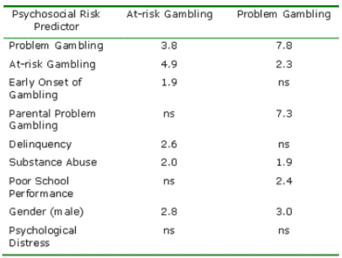Several cross-sectional studies have uncovered a number of psychosocial risk factors for adolescent gambling, such as substance abuse, school problems, and juvenile delinquency (Winters, Stinchfield, Botzet, & Anderson, 2002). While informative, unfortunately cross-sectional research does not allow for temporal sequencing of those psychosocial factors and the development of problem gambling. Consequently, cause and consequence cannot be distinguished. This WAGER reports on a recent longitudinal study of gambling risk factors among adolescents (Winters et al., 2002).
Winters et al. contacted 910 families by phone and at Time 1, 702 agreed to participate in a series of phone interviews. Two years later, they were able to conduct a second interview with 532 members (76%) of the original cohort. At the final interview six years later, 305 (43%) were interviewed1. On average participants were 16 years old at Time 1, 18 years old at Time 2, and 24 years old at Time 3. All three phone interviews included questions pertaining to demographics, psychosocial risk factors, and gambling experiences. The authors explored changes in at-risk (score of 2-3 on SOGS-RA (Winters, Stinchfield, & Fulkerson, 1993) or SOGS (Lesieur & Blume, 1987)) and problem (score of 4 or more on SOGRA or SOGS) gambling over time and the association between adult at-risk and problem gambling and the presence of several psychosocial risk factors (including early gambling) at Time 1 or 2.2
Winters et al. reported that at-risk gambling increased significantly over time, but problem gambling did not. These results are presented in Table 1.
Table 1: At-risk and Problem Gambling over Adolescence and Young Adulthood
Significant odds ratios for psychosocial risk predictors of at-risk and problem gambling are presented in Table 2. An odds ratio greater than 1 indicates an increased likelihood of an event and an odds ratio less than 1 indicates a decreased likelihood. For more information about odds ratios, please see volume 5(29) of the WAGER.
Table 2: Odds Ratios of Significant Psychosocial Risk Predictors (Time 1 or Time 2) of At-risk and Problem Gambling At Time 3.
ns = non-significant.
These results show relationships between psychosocial risk factors during adolescence and gambling behavior in adulthood. For example, individuals with parents who are problem gamblers are about seven times more likely to develop problem gambling than individuals without parents who are problem gamblers. The authors note that many of these factors are similar to those associated with the development of drug abuse and suggest that this may indicate a problem behavior syndrome among adolescents.
This study had some limitations. First, findings related to developmental changes in at-risk and problem gambling rates might be confounded by the change in screening instruments (i.e., SOGS-RA to SOGS) even though the instruments are deliberately similar. Also the attrition rate is very important. Dropouts are a common hazard to longitudinal studies and limit the capacity of scientists to interpret their data with precision and to generalize back to a larger population. In addition, because of the low frequency of reported psychosocial risk behaviors, the authors could not examine Time 1 and Time 2 independently. This restricted the flexibility of the hypotheses that could be tested and precluded time sequencing analyses of the psychosocial risk factors. Consequently, Winters et al were unable to provide a picture of the order of events that lead to problem gambling. At this point, we still do not know how the predictors relate to each other temporally. Finally, the authors do not report the relationship between gambling at Time 1 and Time 2 and risk factors at Time 3. Consequently the cause and consequence relationships that might exist are still unclear.
Nevertheless, this study provides a much needed scientific step in the right direction. The National Research Council of the National Academy of Sciences and others have requested more longitudinal research to study gambling (National Research Council, 1999). Longitudinal research that examines temporal relationships among co-occurring factors is necessary to advance the field of gambling research by clarifying long-term influences and causal influences. Longitudinal research holds the potential to reveal a complex behavioral syndrome of which problem gambling is an important component—or a barometer.
Comments on this article can be addressed to Debi LaPlante.
Notes
1. These individuals were a targeted sample comprised of high-risk and low-risk individuals from the T2 sample.
2. Because the frequency of “hits” for the risk factors was so small, the authors collapsed over Time 1 and Time 2. Thus, a hit at either Time 1 or Time 2 was recorded as the presence of a risk factor.
References
Lesieur, H. R., & Blume, S. B. (1987). The South Oaks Gambling Screen (SOGS): A new instrument for the identification of pathological gamblers. American Journal of Psychiatry, 144, 11841188.
National Research Council. (1999). Pathological gambling: A critical review. Washington D.C.: National Academy Press.
Winters, K. C., Stinchfield, R. D., Botzet, A., & Anderson, N. (2002). A prospective study of youth gambling behaviors. Psychology of Addictive Behaviors, 16(1), 3-9.
Winters, K. C., Stinchfield, R. D., & Fulkerson, J. (1993). Toward the development of an adolescent gambling problem severity scale. Journal of Gambling Studies, 9(1), 63-84.






